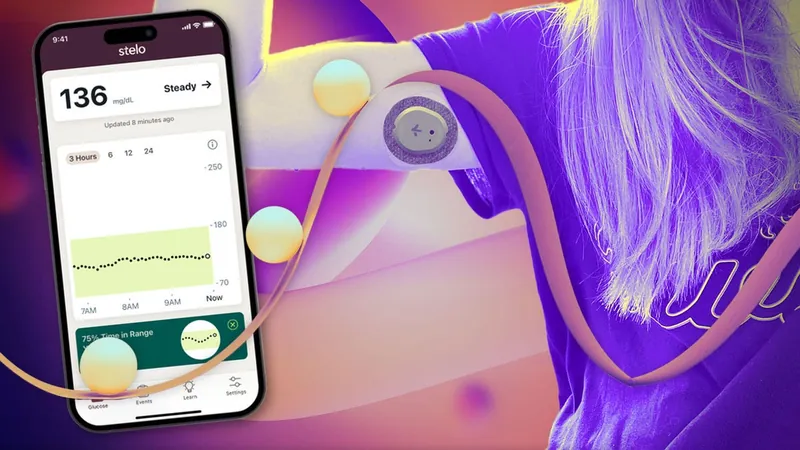
Tracking My Blood Sugar for a Month: The Surprising Truth Behind My Shocking Spikes
2024-09-29
Introduction
For anyone striving for optimal health, it can often feel like you’re straddling the delicate balance between wellness and an impending health crisis. In my quest for health, I have embraced a predominantly vegetarian diet, committed to daily exercise, and ensured I bask in the sun whenever I can. Even with regular blood tests to monitor my cholesterol and glucose levels, I was under the impression that I was on top of my health game—until I decided to try out the Stelo continuous glucose monitor (CGM), recently approved for over-the-counter use in the US.
The Introduction of Stelo
For years, CGMs were primarily reserved for those living with diabetes, requiring prescriptions that came with hefty costs. However, the emergence of the Stelo brought a welcomed shift, allowing non-diabetic individuals like me insight into our blood sugar readings. Initially, I felt quite confident about my health metrics, bolstered by my past lab results and continuous health readings from my smartwatch, which claims my cardiovascular age is significantly younger than my actual age.
Little did I know how wrong I was. The first week of wearing the Stelo was a revelation, but also a stark wake-up call. Blood sugar levels fluctuated in ways I didn’t expect, with my glucose readings varying dramatically throughout the month. This experience prompted me to examine aspects of my lifestyle that I had previously overlooked, such as my chronic sleep deprivation and extended periods of inactivity. While I understood their potential impacts on my health, the visual data provided by the CGM offered revelations that were both shocking and eye-opening.
The Stelo Glucose Monitor: A Dive into the New Age of Wellness Tracking
The Stelo glucose monitor, developed by Dexcom, is a sleek device designed to provide real-time insight into blood sugar levels without the need for a prescription. Intended primarily for individuals managing Type 2 diabetes, anyone looking to understand their glucose levels can use it. With a price point of $99 for a month’s supply of sensors (or $89 with a subscription), it is relatively more affordable compared to similar products on the market.
Using the Stelo was surprisingly straightforward. After downloading the companion app and creating an account, I was ready to attach the biosensor to my arm. The insertion was painless and, contrary to my initial apprehensions, the setup process was stress-free.
Once connected, I began logging my meals and activities in the app. However, I quickly learned that logging every ingredient was going to be tedious. I opted for a simpler approach, noting the main components of my meals, which gradually helped streamline my tracking process without feeling overwhelmed.
Unexpected Insights: The Meal That Crashed My Blood Sugar
A particularly eye-opening moment arrived during a hectic workday when I consumed what I had deemed a healthy salad. Despite its vegetables and high nutrient profile, my blood sugar soared above 140 mg/dL, a threshold I had been closely monitoring. The event sparked a frenzy of questions: Was my glucose spiking due to stress, or was my stress rooted in the blood sugar spike? These unanswered queries lingered as I continued my journey.
I also discovered some surprising behaviors in relation to favorite indulgences. For instance, my weekend brunch of a veggie omelet on a salt bagel resulted in one of my highest glucose spikes—evidence that healthy doesn’t always equate to low sugar.
As the weeks went on, my body started adjusting. I focused on increasing protein intake, especially in the mornings, and made it a point to get moving after meals. Consequently, my average glucose levels began to stabilize.
When Should You Worry? The Confusion of Blood Sugar Metrics
One major concern that emerged from my month-long tracking was determining what glucose spikes were normal. Recommendations from experts suggest that non-diabetic individuals should stay under 140 mg/dL, particularly after meals, but there’s a gray area. According to Dr. Scott Isaacs, an endocrinologist, short-term spikes can be completely normal and may not warrant immediate concern. His insights offered some peace, although the uncertainty around my own readings kept me questioning.
The Stelo's primary purpose is to empower those at risk of Type 2 diabetes, offering real-time data and encouraging healthier choices. While I saw some promising trends, it left me pondering broader questions about wellness in my life.
Final Reflections: Lessons Learned From a Month of Tracking My Glucose
Ultimately, my month of blood sugar tracking provided me with a wealth of insights into my health. These insights extended beyond numbers; they illuminated the impact of my daily habits on my body's sugar regulation. Simple adjustments—like incorporating more protein, recognizing the effects of stress, and enhancing my sleep hygiene—have become paramount in my daily routine.
Of course, this journey also highlighted my previously overlooked habits that could compromise my long-term health. It’s easy to dismiss chronic sleep deprivation until confronted with the realities of its impact.
I may have set out simply to monitor my blood sugar, but what I gained was so much more—an awareness of how interconnected my body’s responses are and the importance of maintaining a holistic approach to well-being.
For anyone considering the leap into glucose monitoring, be prepared for a journey that might redefine your understanding of health—but remember to consult a healthcare professional for guidance personalized to your situation. In an era where technology can empower us in our health choices, data serves as a vital tool—but your understanding of that data is where the true transformation begins.



 Brasil (PT)
Brasil (PT)
 Canada (EN)
Canada (EN)
 Chile (ES)
Chile (ES)
 España (ES)
España (ES)
 France (FR)
France (FR)
 Hong Kong (EN)
Hong Kong (EN)
 Italia (IT)
Italia (IT)
 日本 (JA)
日本 (JA)
 Magyarország (HU)
Magyarország (HU)
 Norge (NO)
Norge (NO)
 Polska (PL)
Polska (PL)
 Schweiz (DE)
Schweiz (DE)
 Singapore (EN)
Singapore (EN)
 Sverige (SV)
Sverige (SV)
 Suomi (FI)
Suomi (FI)
 Türkiye (TR)
Türkiye (TR)